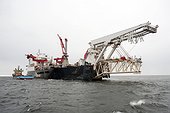World’s Largest Pipelay Vessel Starts Laying Pipe for Nord Stream in the Gulf of Finland
- Allseas’ Solitaire Starts Laying the Pipeline in Russian Waters
- Nord Stream and Allseas Executives on Board to Confirm Start of Construction
Sept. 1, 2010 | Zug | Allseas’ Solitaire, the world’s largest pipelay vessel, has started to lay the Gulf of Finland section of the 1,224 kilometre Nord Stream natural gas pipeline in the Baltic Sea. Nord Stream’s Deputy Director Construction Ruurd Hoekstra and Leo D. Varkevisser, Allseas’ Vice President Projects and Operations, arrived on board the Solitaire to confirm that everything is on schedule and “all systems go” for the start of construction. Before starting its journey to Russian waters, the Solitaire was adapted to Nord Stream’s requirements in Rotterdam, where each piece of equipment was thoroughly tested in port.
The Solitaire has taken up laying the pipeline 7.5 kilometres from the Russian landfall and will continue in a westerly direction through the Gulf of Finland to kilometre point (KP) 300. Afterwards, in January 2011, the pipelay vessel will move on to KP 350 and lay the pipeline back towards KP 300. The Solitaire will also lay the same section of the second string of the pipeline from May to September 2011. The dynamically-positioned Solitaire will operate without anchors in this congested part of the Baltic Sea known for its many historic mine lines.
The section of both strings of the pipeline between Russian landfall and KP 7.5 has already been laid by another pipelay vessel, Saipem’s Castoro Sei, which is currently laying the pipeline in Finnish waters in an easterly direction between KP 451 and KP 350.
This complex lay sequence was developed by Nord Stream and agreed with the Finnish and Russian authorities to meet environmental restrictions while making the construction vessels work as efficiently as possible. To give just one example: there will be no construction works in the north-eastern part of the route in winter when it is covered by ice; this also ensures that breeding seals are not disturbed.
Construction of Nord Stream – the most advanced of the new pipelines that Europe will need to meet its future energy requirements – is progressing on schedule and according to plan. Over 250 kilometres of the first pipeline have already been laid in Swedish and Finnish waters. At the Russian landfall in Portovaya Bay, close to Vyborg, and at the German landfall at Lubmin, near Greifswald, both strings of the pipeline have already been constructed and pulled ashore.
When completed in 2012, both strings of the Nord Stream pipeline will be 1,224 kilometres long and comprise 202,000 concrete weight-coated steel pipes each weighing up to 23 tonnes. The Nord Stream Pipeline will transport 55 billion cubic metres (bcm) of natural gas a year to Europe, enough to supply more than 26 million European households.







